A Modern Perspective of the European City. 100 X Berlin by Laszlo Willinger and 100 X Paris by Germaine Krull[1]
Abstract
In 1929, two books were published by the German publisher Verlag der Reihe concerning the modernising European city. One book was about Berlin, authored by the Hungarian photographer Laszlo Willinger; the other presented Paris, containing photographic shots taken by the German-French photographer Germaine Krull. This article analyses not only the different visual strategies employed by each of these photographers to translate this process of modernisation into photographic images, but as well devotes attention to the format in which these images were presented, specifically the photobook. Through a detailed examination based on layout and design, this article attempts to clearly demonstrate how the photobook enables its reader to experience the city from a new and characteristically modern perspective.
Article
Introduction
When compared with the American metropolis, the European city of the early twentieth century was seemingly of little interest for a form of photography that considered itself radically modern. There was simply too much history grouped together in those (all too) solid buildings. No matter where the inhabitant of the European city looked, he always had to face distinguished monuments, stately houses, and impressive churches—i.e. the proud remains of a monumental past. This somewhat imposing urbanity, proudly expressing its past, served as a continual reminder to the modern individual that he could never undertake anything by starting from nothing, but that his existence was firmly imbedded in traditions and memories. Ultimately, however, the European photographer who fancied himself as modern was going to have to take on this unwieldy, somewhat reticent subject. His modernity is therefore often (but not always) a modernity of form, not of content: the European photographer shows his solidarity with the modern project—not so much through the registration of modern architecture (office buildings, imposing skyscrapers, industrial sites, movie theatres, or bars)—but through the development of a new (and sometimes neck-breaking) view of the historic city.
Modernity in the nineteenth century versus its twentieth-century variant
Of all the cities of Europe, Paris seemed the most logical place to express a sense of modern living. It had played this role once before in the nineteenth century. It was then that the poet and art critic Charles Baudelaire evoked the lively modernity of Paris in his later poems about the city. The city photographers Charles Marville (1813-1879) and Eugène Atget (1857-1927) responded to the large-scale renovation project that Haussman carried out under the commission of Napoleon III. Charles Marville, who was hired by Haussmann, coldly registered the demolition of the old and the building of the new.
Marville’s vantage point—as stipulated by the commission, i.e. always at an intersection and directly on the axis—already anticipates Haussmann’s planned transformation: the zigzagging alleyway, so prohibitive for a smooth flow of traffic, is to be replaced by a straight, broad lane, referred to as the ‘boulevard’. Eugène Atget, the visual poet of the city now subjected to Haussmann’s sentencing, decides resolutely in favour of what is left of the old Paris. In his images of streets and alleyways, Atget recalls the slow rhythm of someone walking in the old neighbourhoods of the city: his photos are often constructed in such a manner that the viewer is offered a richly varied trajectory (these are spaces where one is obliged to investigate slowly, not where one rushes through hastily). His later photos of storefront windows question the spatial experience unique to the modern metropolis even more explicitly. Through the play of reflections in these storefront windows, the urban space takes on a phantasmagorical quality, thus becoming essentially uncontrollable (and therefore uninhabitable). These images—where interior and exterior flow into each other and where movement through the different spaces never seems to end—visualise the fundamental elusiveness of a city in which its inhabitants live as individuals uprooted (therefore no surprise that it was precisely in these images that the surrealists observed a premonition of their vision of the city as a source of exquisitely disorienting effects).
The common assertion that these proto-modernist city photographers ignored the residents of the city must for this reason be put into perspective. While the busy city-dweller might perhaps have played no significant role in the photographers’ images (occasionally we observe a full or partial shadowy figure looming), his shifting experience of the city is most certainly addressed. Paradoxically, this becomes visible through the manner in which both of the photographers employ ’emptiness’. With Atget, the void stands for what was taken down by Haussmann, the product of a crime that occurred just outside the image’s borders—a melancholic lament for what has been lost and for the incapacity of photography to resurrect what is absent. With Marville, the empty spot in the city is not so much an open wound in the old fabric, but rather the herald of the modern building project. In this manner, Atget’s and Marville’s urban spaces become a projection screen of the hopes (and fears) with which the Parisian city-dweller looks towards the future.[2] Marville glances forward, Atget backward; one exalts the slow pace of the loiterer in the alley, the other the frenetic speed of the traffic on the broad boulevard; one stands in favour of modernity, the other disapproves of it. The two men’s differing approaches allude to a break in the experience of time, to a temporal crisis, caused by the ‘acceleration’ that is characteristic of the modernising metropolis.
The modern city is an extremely hectic and exhausting universe. The acceleration of life’s rhythm especially places traditional social relationships under pressure. The enforcement of a stricter temporal regime at the workplace on one hand, and the increase in superficial and fleeting contacts on the other, lead to a far-reaching individualisation of social interaction. New attitudes dominate the social field: punctuality, reliability, accuracy and precision become the new values. Precisely because photography distinguishes itself through the same properties—i.e. as a punctual, extremely precise and reliable medium—it seems perfectly suited to the visual exploration of this new social order.[3] At the same time, however, the photography of the nineteenth century proves as yet unprepared to take on such a task: the processes are too cumbersome, the cameras too heavy, the formal conventions too strict, the tripod too restrictive. While the photo itself can be taken in an instant—by the end of the nineteenth century within a fraction of a second—the time-space captured in this manner remains eerily frozen (inviolable invariable). Only with the arrival of a new generation of light, handy and extremely manoeuvrable 35mm cameras does the photographer begin to explore (and to exploit) the true instability of the moment. In urban photography this leads to the birth of a new practice: street photography. No longer are the streets and squares, churches and monuments the central topic, but rather the turbulent, exciting, ever-shifting life on the street, the people on the sidewalks, the traffic on the road.
Street photography is therefore the genre that best serves to depict the effects of modernisation on the city inhabitant. Yet we still see that traditional architectural photography continues to dominate photobooks on the city published during the Interbellum. This by no means suggests, however, that these works provided a static interpretation of the modern metropolis. In this respect, a comparison between two photobooks from this era can serve to clarify. Both 100 X Paris and 100 X Berlin (produced by the same publishing company, Verlag der Reihe, in Berlin) attempt to capture the contemporary appearance of the urban environment within the framework of one hundred photos. Remarkably, each follows an entirely different photographic strategy. This difference is undoubtedly also linked to the way in which the process of modernisation actually progresses in both cities as well as the intense competitive struggle between the two cities—both Berlin and Paris, after all, are trying to present themselves as the epitome of urban modernity. Yet the difference in approach between the two photobooks is also related, perhaps even more significantly, to the presence—or rather absence—of buildings and structures that one considers ‘modern’.
Berlin versus Paris
Starting in the 1920s, the modernisation enters a period of greater acceleration, with the contrast between the old and new becoming more visible in the appearance of the city street. The automobile is demanding more space, and through its success, an entirely new traffic infrastructure emerges. Public street lighting is no longer supplied by gas but electricity, which lights up the night spectacularly. The industrialisation of manufacturing processes necessitates the building of large industrial sites in the heart of the city. Furthermore, the intensive bureaucratification of civic life in the still nubile democracies requires new, large-scale administrative temples. In short, the modernisation of the political, economic and social aspects of life leaves its mark in the urban fabric. Yet this process does not take place in the same rhythm everywhere. Paris, for instance, evolves more slowly than other European cities. Only in 1962 is the entire city fully connected to the electrical grid, for instance.[4] For this reason, Paris could no longer be viewed as the ideal embodiment of this new wave of modernisation. The brand new German capital, Berlin, is a very different case. Hardly weighed down by an imposing past, it appears perfectly suited as a laboratory for urban renewal (a project that both the Weimar Republic and the later Nazi regime carry out with tremendous enthusiasm).
In his introduction to 100 X Berlin, Karl Vetter underscores the exceptional position of the new capital of Germany.[5] While all other European capitals have served as the political and cultural centres of their respective countries from the very beginning, Berlin is the exception. The city’s function as a capital is not only of recent date, but it likewise has to compete with other regional centres that had previously played an important political role (such as Munich, for instance, which had once served as the residence of the German emperor). In addition, the author cites the city’s location as a factor contributing to its unusual character. As a centre of transit between east and west, Berlin has been lacking in definition. Not until the nineteenth century does a new image for the city emerge from this mishmash—bestowing a certain unity on the city for the first time. The absence of a deeply rooted tradition also manifests itself in its urban architecture: Berlin has no monuments that date back any earlier than the eighteenth century (while smaller German provincial cities often do). The city’s most important architecture is exceedingly modern: office buildings and warehouses in the centre; in the periphery, modern residential neighbourhoods and industrial sites. Finally, Vetter briefly sums up the city’s qualities that make it a role model of modernity: Berlin is an important centre of industry and finance (the most important German banks are headquartered there), it serves as the heart of the illustrated press in Germany, and it is an in intense traffic hub (with Germany’s largest inland harbour and a modern airport). Together with the airport, Vetter as well acknowledges the transmission tower in Witzleben as one of the most important realisations of modern architecture in the city. He closes his introduction with a reference to the remarkable upsurge that has taken place in art (modern theatre and cinema) and science in Berlin.
To give an impression of this brand new city, it therefore suffices to document the contemporary buildings: the modern photographer can continue to photograph according to the topographical method established in the nineteenth century. And this is precisely what the German photographer Laszlo Willinger (1909-1989) does in 100 X Berlin. The book opens with a series of architectural shots, featuring various imposing office buildings and industrial sites that have been built in the last ten years. For instance, the opening image shows an ultra-modern printing company in Tempelhof, where magazines such as the Berliner Illustrirte Zeitung are printed. (Fig. 1) This immediately sets the tone: Berlin is above all a progressive city with a booming industry. Elsewhere in the photo book as well, abundant attention is given to precisely those aspects of the city that make it a model of modernity. A photo of the Tempelhof Airport, the transmitting tower at Witzleben, or the enormous electricity plant in Rummelsburg are naturally not to be overlooked in this presentation, with attention likewise given to the modern-day spectacle (theatre and sport). (Fig. 2) As such, it appears as if the photographer was simply checking off items on Vetter’s list. Willinger seeks out and shows those very places where the city makes itself modern: this explains why the book only comprises images of sleek office buildings, impressive stores, the modern infrastructure, and finally, the culture of large-scale spectacle. (Fig. 3) This working approach likewise determines the ordering of the images: they are placed neither in narrative sequence, nor opposite each another in harsh confrontation. Instead, they follow one after the other according to a demonstrative logic. Each image functions as a definitive argument designed to convince the reader of Berlin’s modernity. In short, Berlin is to be considered a modern city because it is filled with modern buildings, because the infrastructure is responsive to the needs of contemporary society, and because the spectacle there is grand and engaging.
 |
Fig. 1. Laszlo Willinger, 100 X Berlin, 1929, p. 1. |
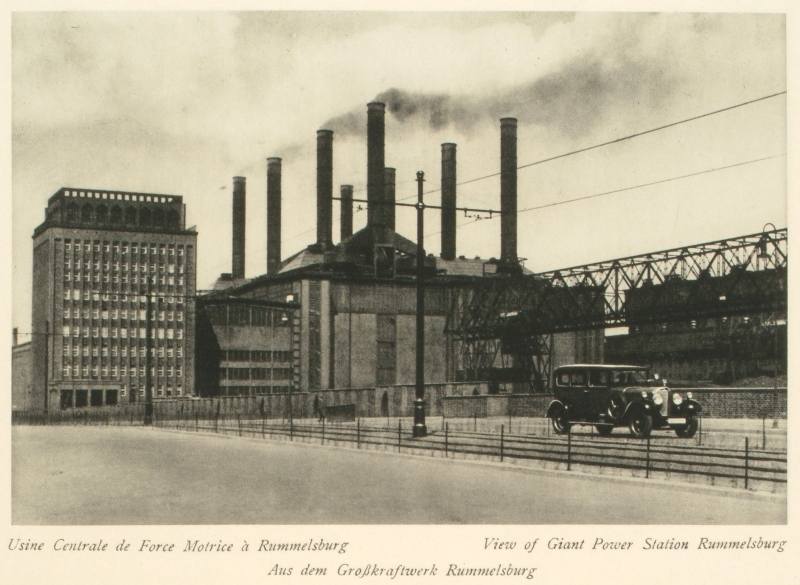 |
Fig. 2. Laszlo Willinger, 100 X Berlin, 1929, p. 20. |
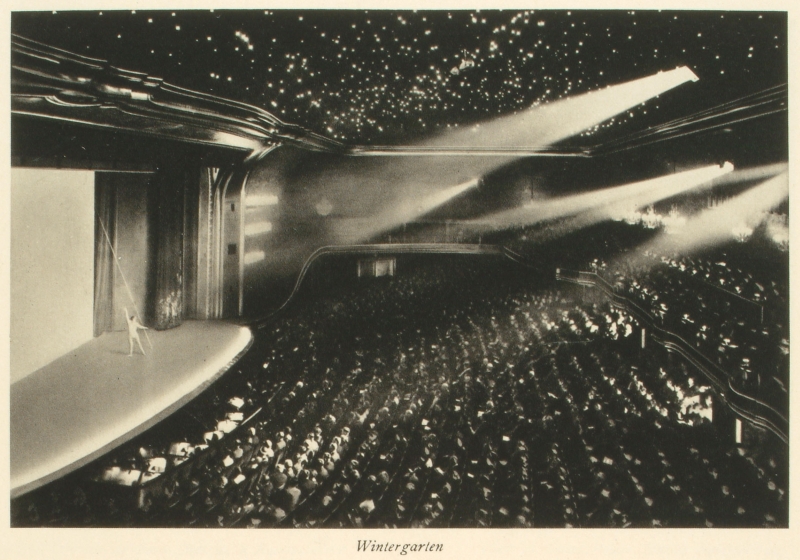 |
Fig. 3. Laszlo Willinger, 100 X Berlin, 1929, p. 22. |
Modern Paris—The Eiffel Tower
A historic city like Paris, where the scars of a turbulent past can still be seen everywhere, is far less suited to such a photographic strategy. The only somewhat modern looking architectural work is the Eiffel Tower, a metal structure dating from 1890. The attention it draws from many modern artists seems to confirm the exceptional place it occupies within the city. As such, the tower unites two aspects of modernity: as an influential industrial product designed by engineers and not by architects, and as a construction built in cast-iron (the material of modern industry), it refers to the industrial modernisation of the nineteenth century; as a motif of the avant-garde, it points towards the latest trends in the arts of the twentieth century. In this growing attention for the Eiffel Tower as a modern motif, photography plays a significant role. A whole line of photographers (Laszlo Moholy-Nagy, André Kertesz, Ilse Bing, and especially also Germaine Krull) discovers the tower as a machine for producing new, astonishing vantage points and unnerving visual experiences. In line with the modern-day adage ‘only from the destruction of what is old can something new arise’, they use their camera to derive new stimulating images from the tower. Gone are the distant, well-organized images that firmly ground the Eiffel Tower in its urban context. Instead, images appear that break up the tower into illegible fragments and transform it into a visual rebus.
The iconoclastic treatment of the Eiffel Tower produces a very specific (and intentionally disorganized) visual experience. Mind-boggling perspectives take the unsuspecting viewer on a virtual roller coaster, sending him in a fast descent only to soar again at great heights with a brutal jerk. The absence of a stabilising horizon line strengthens the disorienting effect even more: the viewer flies in a boundless space, with no references to determine what is up and what is down. This energising visual experience is only possible because the photographing body has also liberated itself: freed of the weight of a heavy camera as well as the immobile nature of the tripod. The camera becomes a prosthesis of the eye, the extension of a body that is supple one moment and spastic the next. Paradoxically enough, it is precisely the photographer’s physical liberation that signals the loss of the viewer’s freedom of movement: from this point forward, the latter can now do nothing else but follow the course that the photographer has laid out for him. The open image of the nineteenth century that offers a complex whole comprised of possible trajectories (see Atget) now changes into a closed one that forces the viewer into the straitjacket of single-point perspective in dictatorial fashion. In order to fully enjoy the physical euphoria promised him by this wild carnival ride through the image, the viewer—if only for his own safety—has no other choice but to obediently follow the standard path laid out for him. Experiencing a momentary calm or delighting in the panoramic vista is no longer possible: instead he is thrown at the target like a ball shot out of a cannon.
This radical reinterpretation of the Eiffel Tower leads not only to the development of a formal instrumentation that allows one to document the ‘old’ Europe in a ‘modern’ manner—i.e. the lessons obtained from the new treatment of the tower are immediately applied to the older, more sturdy, buildings[6]— but likewise teaches the modern photographer how to activate the body of the viewer. The Eiffel Tower is not only an object that sharpens his view, but also a playground for exploring previously unknown physical sensations. The photo camera gives rise to an ecstatic body that allows itself to be catapulted into space without any reservation. It is especially this last aspect—i.e. the capability of photography to stimulate the body of the viewer in various ways—that is realised in Germaine Krull’s 100 X Paris in a spectacular manner.
100 X Paris—clashing perspectives
Barely one year after her loose-leaf publication Métal, Germaine Krull (1897-1985) publishes the photobook 100 X Paris in 1929.[7] In this photobook, Krull appears to give an entirely different interpretation of the urban modernity of Paris when compared to her previous work, with its highly disorienting visual idiom. Here there is no excess of exciting worm’s-eye and bird’s-eye views, or harsh frames. Instead one finds an almost classical, elucidating, descriptive visual idiom.[8] The Eiffel Tower, for instance, appears only once in the book, albeit in a highly symbolic place. Featured as the very last image, the night shot of a brightly lit tower demarcates the fairylike final destination of a day-trip around the city. The choice to photograph the tower from a respectable distance (which makes it seem as if the tower is sinking into the surrounding shadows) allows it to function more like a poetic element—completely subsumed in the historic fabric of the city—rather than a symbol of a modern Paris that radically breaks with its past.
Such a treatment of the Eiffel Tower is perfectly in line with the image of Paris portrayed by the author of the book’s introduction, Florent Fels, who sees the city as a place where one cannot help but be confronted by its history: every corner is filled with memories (both personal and collective). The historic density is so high, as Fels puts it, that the ghostly image of an imaginary city appears to hang over the actual city. This is true not only for the inhabitants of Paris, who know the city intimately, but likewise for its visitors. They, too, already have an image of the city formed in their minds. Paris is a city that has been praised many times over, whether in the poems of Nerval and De Musset, or in the lyrical cityscapes of engravers such as Callot and Clouet, and painters like Monet and Manet. Fels explicitly relates Krull’s images to the work of these big names: her images are supposed to revitalise the love of these major artists for their city on behalf of a contemporary public.
Despite the many references to ‘historic’ Paris, Krull’s discussion of urban space is anything but classical or traditional. It is very much a modern interpretation of Paris that she wishes to present in 100 X Paris. The difference is that she does not (purposefully) resort to the instrumentation of the ‘neue optik’ to illustrate a contemporary experience of the city. She takes advantage of the book’s structure and the opportunities provided by its layout: in the architectural space of the book, Krull sets photos against each other or threads them together in longer sequences. An excellent example of her working approach is provided by images eight and nine: featured on a spread, Krull places the hectic traffic opposite an old and deserted alleyway. (Fig. 4) The urban congestion, brought about by a quintessentially modern means of transportation, is juxtaposed against the calm of the old Paris. The noisy modern city and the peaceful, romantic city provide its inhabitants with two radically different sensations.
 |
Fig. 4. Germaine Krull, 100 X Paris, 1929, pp. 8-9. |
In her book, Krull doesn’t use much street photography (a genre she has nevertheless practiced in the past and an area in which she also excels, if acknowledging the reviews of her day), but instead she remains faithful to the conventions of the traditional city photobook, which attempts to tell the city’s story primarily through its monuments. Of these, there are plenty to admire in her book: from the Notre Dame Cathedral via the Arc de Triomphe, the Dôme des Invalides, and the Hôtel de Ville to the Eiffel Tower. Yet this focus on the architectural legacy of the city threatens to weaken another of the book’s ambitions, specifically the evocation of the dynamic of the modern metropolis. Buildings do not move and evolve only very slowly: they symbolise more of an obstinate intransigence rather than change (even ruins throw us into a melancholic contemplation of human temporality, rather than inspiring a lively desire to take action).
The manner in which Krull reconciles these conflicting ambitions with one another becomes evident in the way in which she presents (and memorialises) the relationship between the monument and the modern city. An analysis of a spread, in which she unites the image of a policeman overseeing traffic with a photo of the Dôme des Invalides, provides insight into her working method. (Fig. 5) At first glance, the relationship between both subjects seems obvious: they belong to opposing (and mutually excluding) temporal regimes. The policeman, who watches over the traffic speeding by, is obliged to be especially alert and able to take quick action: his attention is exceedingly fleeting and instantaneous. Directly opposite, the Dôme des Invalides contradicts this experience of time: the observation of a monument—the eternalising of a time-space that has come and gone—requires an entirely different mentality than when viewing a policeman completely absorbed in the ‘now’. This contrast, however, is toned down by the vantage point from which Krull photographs the Dôme des Invalides: she is standing in the middle of the road—not on the sidewalk—with her camera tilted ever so slightly to the right. Vantage point and viewing direction suggest a perspective from a moving automobile, as if the driver (or passenger) just briefly points out the monument. There is too little time to linger. Instead of contradicting, the images on the spread now seem to strengthen each other: both display the effects of the new temporal regime (speed, punctuality, hastiness) on the experience and observation of the city.
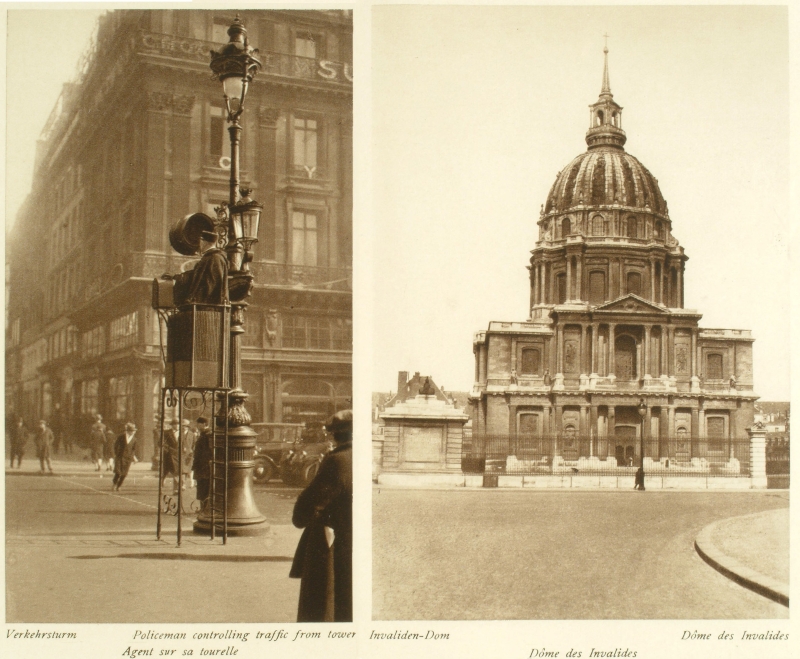 |
Fig. 5. Germaine Krull, 100 X Paris, 1929, pp. 44-45. |
Elsewhere in her book as well, Krull uses the spread in order to convey to the reader something of the hectic energy and kinetic excitement of the modern city. Another example is a spread showing an image of pedestrians on the Avenue Bois de la Boulogne that faces a panoramic view of the city taken from the Eiffel Tower. (Fig. 11) One image is a street photo (one of the few street scenes found in the book), the other offers a topographical analysis. One image suggests a direct contact with the city, while the other provides a view of the city that is detached and aloof. From being a place to walk—intimate and confidential—the city becomes an abstract map. This sudden and harsh transition from a microscopically small space to one that is macroscopically large sends the reader spinning. It can be read as an evocation of the clashing perspectives that the pedestrian encounters on a daily basis—perspectives that put him off balance. Such abrupt shifts in perspective occur quite often in the book, such as the spread devoted to various entrances to the Louvre. The image on the left shows the entrance at the Place du Carroussel, while the image on the right depicts the entrance at the Quai des Tuileries. The repetition of the same motif (with the only difference being that we find ourselves standing much closer to the monumental entryway in the second image) adds nothing new to the analysis of the city. It does, however, allow the photographer to escort the viewer through this small part of Paris in a fast-paced pirouette.
 |
Fig. 11. Germaine Krull, 100 X Paris, 1929, pp. 38-39. |
100 X Paris—a sequence
Besides zooming effects—clearly cinematographic in nature—Krull also applies another ordering principle borrowed from film in this book: the sequence. One rather lengthy sequence is particularly noticeable. Krull begins with a full view of the Paris Opera. By choosing a relatively high camera angle, her emphasis lies not so much on the building itself, but rather the lively activity occurring on the square in front of it: heavy automobile traffic moving along its edges, countless pedestrians on the square itself, and in the middle, the entrance to the metro. The three most current ways to get around the city are brought together in a single image. In the next shot as well, the reader finds himself on the same square. Together with the photographer, he plummets in the direction of the urban hustle and bustle. (Fig. 6) The monumental opera building disappears completely from the field of vision, with all attention now focusing exclusively on the teeming masses on the square. It is just the beginning of a descent, which in the next image, suddenly thrusts the reader into the urban flux. It is not the desire for a more precise and comprehensive image of the static monument that draws the photographer down, but the fascination for the flowing dynamic (and chaos) of life on the street. This downward movement can correspondingly be interpreted as seeking a direct confrontation with the city: her vantage point is not characterised by an aristocratic detachment, but rather an intimate interaction. Once on the street, the second part of Krull’s adventurous tour commences. (Fig. 7) The vertical dynamic is now replaced by the horizontal. The photographer draws the reader into the circulating traffic, passing by the Boulevard des Capucines, along the Champs Élysées, and taking him right up to the foot of the Arc de Triomphe. For three consecutive spreads, Paris is nothing else but a parade of passing automobiles (an image of the city that hardly corresponds with the standard touristic views of Paris). Krull photographs the city, not from the safety of the sideline, but standing directly in the middle. Her working area is not the sidewalk, but the asphalt: no stoop is to be seen—a possible place of refuge in the event the city’s traffic becomes somewhat overbearing. Together with the photographer, the reader gets caught up in the action, completely unprepared. Krull’s vantage point clearly demonstrates that the modern photographer and the viewer no longer wish to be idle spectators, but actively seek out confrontation.
 |
Fig. 6. Germaine Krull, 100 X Paris, 1929, pp. 28-29. |
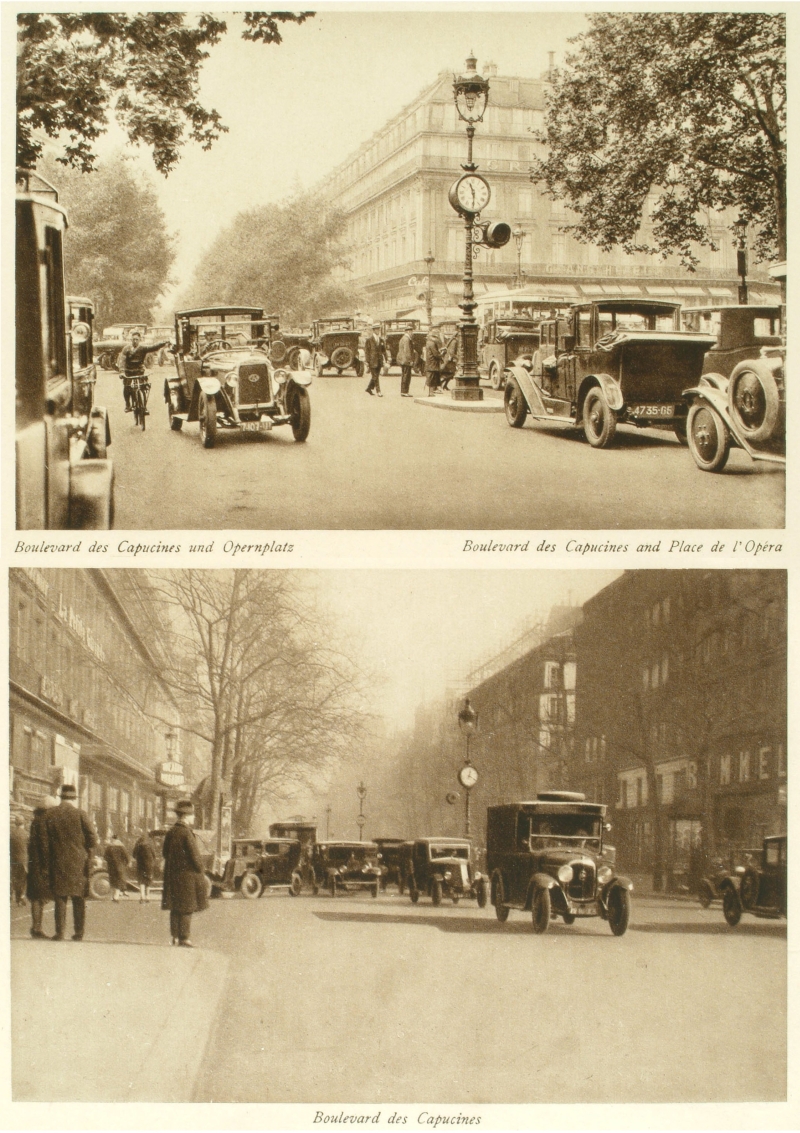 |
Fig. 7. Germaine Krull, 100 X Paris, 1929, pp. 30-31. |
Once the final destination of this brief, but frenzied automobile ride across the city is in sight, the horizontal dynamic of the traffic makes way for a vertical ascent. (Fig. 8) At the foot of the Champs Élysées, Krull’s camera shoots steeply into the heights. From high up above, the reader shares the photographer’s view over the Champs Élysées, a vista crowned by the Arc de Triomphe. The positioning of the triumphal arch to the upper left (and as an extension of the diagonal line that draws the street through the image) leads one to suspect that this will be his destination. And indeed, in the next image the reader stands eye-to-eye with the monument. (Fig. 9) With the assistance of a telescopic zooming effect—the photo appears to be an exact, but enlarged copy of the previous image—he is transported to the triumphal arch in one fantastic tug. Still vibrant from all this kinetic excitement, the next two images draw the reader into another round of seesawing motion. Having come to a startling standstill directly in front of the monument, in the next image he suddenly finds himself standing atop the triumphal arch, looking down onto one of the busy traffic arteries that flows into this circular square. The friction between a body catapulted into the air and a view that remains directed downwards instils this image with an astounding tension. The viewer receives no stabilising, calming overview, but only a steep perspective to what lies below (the call of the deep). In the next image, he again falls victim to gravity and is immediately pulled downward, allowing him to pause but for a moment at the monument of the Unknown Soldier, situated at the foot of the Arc de Triomphe. (Fig. 10) Yet even before he is able to enjoy a moment of peaceful contemplation, the viewer is once again slung upwards to the top of the monument. He bounces up and down, like on a trampoline, and even the final images of this long sequence give him a queasy feeling in his stomach. A dizzying perspective leading directly down to the ground serves as a premonition of what follows in the next spread: he finds himself suddenly standing among other pedestrians on the Avenue du Bois de Boulogne – only to be shot upward once again in the final image. (Fig. 11) But instead of the Arc de Triomphe, this time he is standing on the Eiffel Tower, which provides him with a view of the monument he has just left behind. This panoramic view, with the tower serving as a lookout post, immediately signals the final destination of this wild ride across the city. The reader regains his balance. After having been hauled around the city like a rag doll, he is finally permitted a moment’s rest.
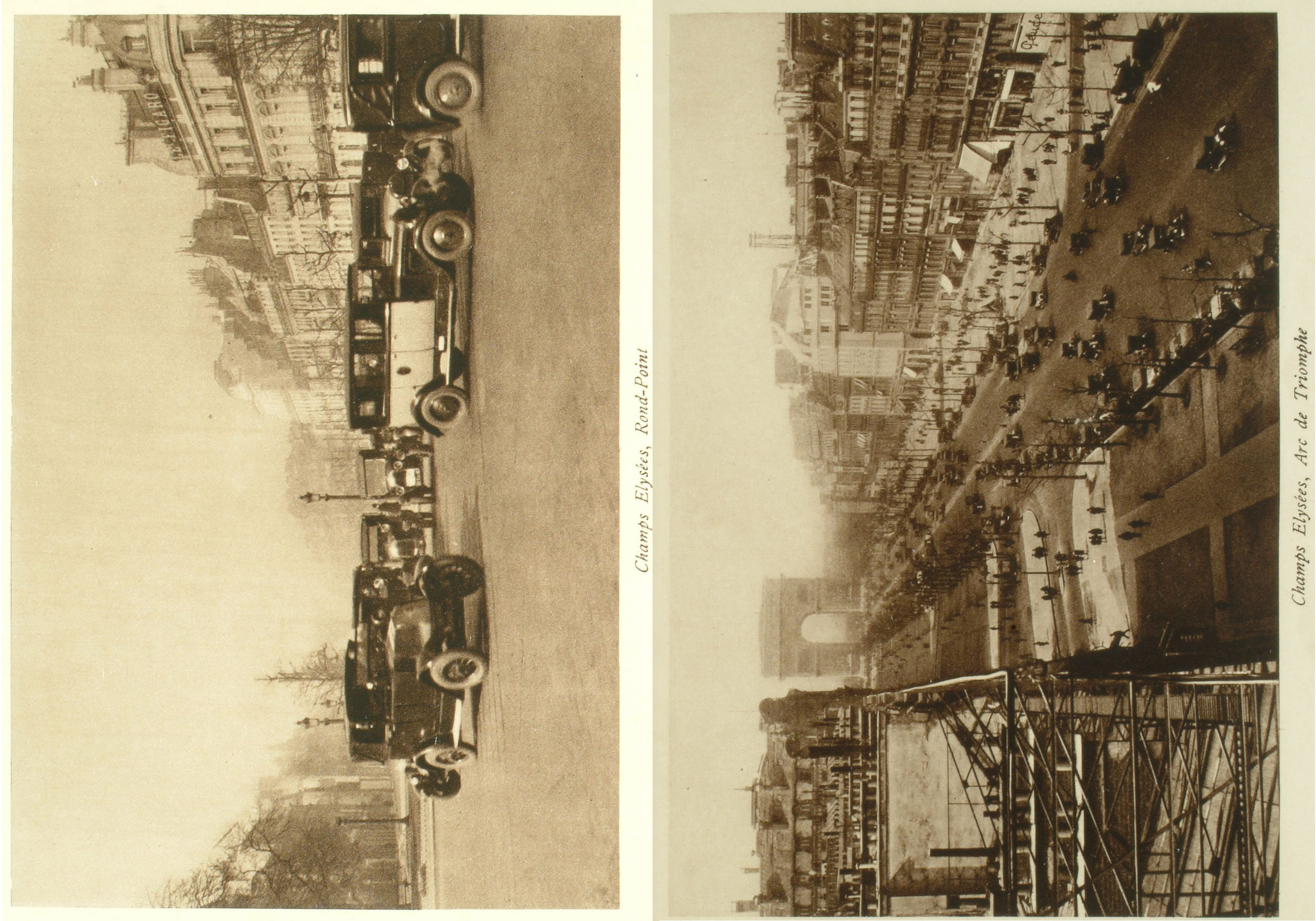 |
Fig. 8. Germaine Krull, 100 X Paris, 1929, pp. 32-33. |
 |
Fig. 9. Germaine Krull, 100 X Paris, 1929, pp. 34-35. |
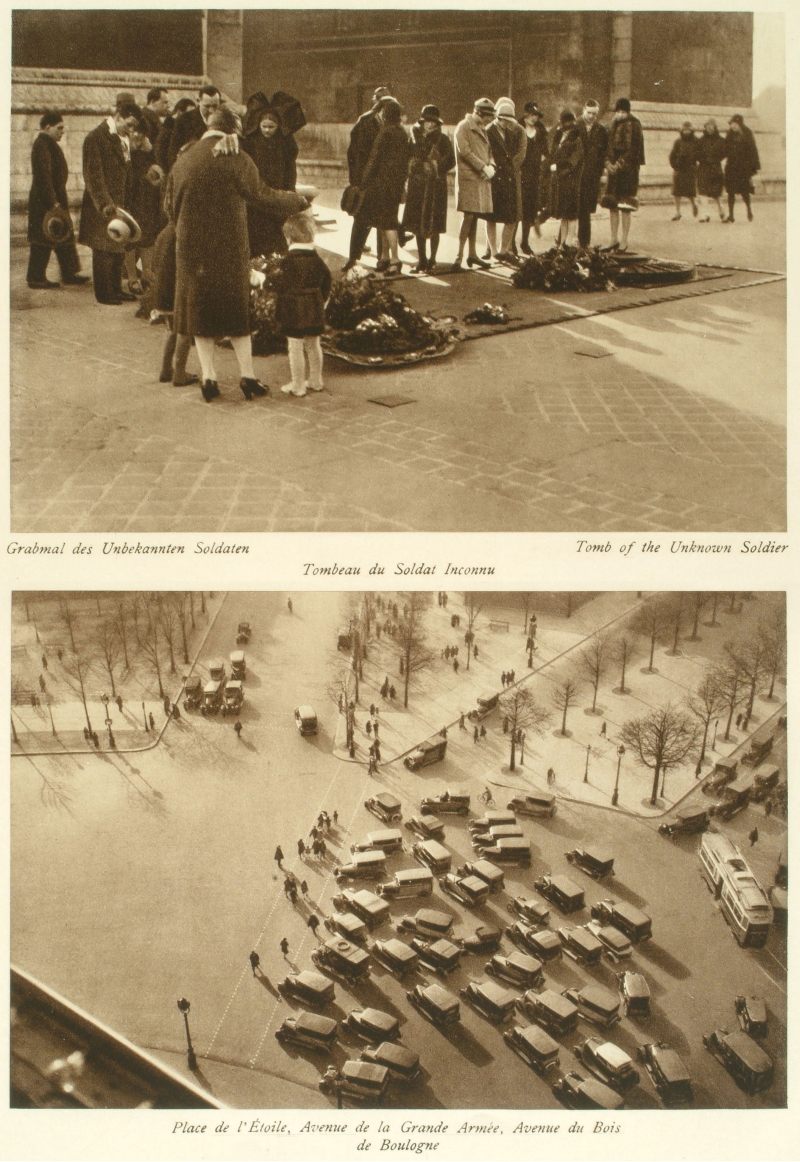 |
Fig. 10. Germaine Krull, 100 X Paris, 1929, pp. 36-37. |
Conclusion
In the twentieth century, the European city modernises at a great pace: imposing skyscrapers make their entry, the architectural style becomes more austere, neighbourhoods emerge based on new principles of urban planning, the automobile takes possession of the street. The photobooks analysed above interpret this process of modernisation in different ways, a difference that manifests itself primarily in the photographic strategy applied. Whereas Laszlo Willinger wishes to demonstrate the modernity of Berlin through the new architecture going up in various parts of the city or the large-scale infrastructure brought about by the arrival of new modes of transportation (airport, roadway, metro), Germaine Krull opts for a more surprising approach. Her presentation of Paris suggests that the city’s modernity is not found in any one specific building, infrastructure or function, but rather in another experience of the city. Paris is modern because one sees it differently, because a new optical regime has taken over, because a new vantage point has been introduced. This new vantage point is that of a person sitting behind the steering wheel of an automobile (that Krull literally began to photograph in this manner following the purchase of her first car in 1929 is certainly no coincidence).[9] As described above, the analysis of the sequence found in 100 X Paris illustrates the key role that the automobile plays in this book: not only does the automobile figure continuously in her images, but she also allows the viewer/reader to (literally) experience how it feels to see the city from a moving vehicle. By toying with the orientation of the images on the spread—vertical and horizontal photos alternate, with the horizontal images printed vertically—the viewer/reader is frequently obliged to turn the book ninety degrees in either direction while paging through the sequence. With the book functioning as a steering wheel in his hands, he makes his way along a hitherto unseen path through the city.
CV
Dr. Steven Humblet (b. 1970) is an assistant-tutor in the history and theory of photography at the LUCA School of Arts Brussels. He holds two MA degrees, one in philosophy and one in social & cultural anthropology, both obtained at the KU Leuven, as well as a doctoral degree in art science from Ghent University (UGent). Between 2003 and 2013, he was a researcher for ‘Citygraphy’, a multidisciplinary research project on the topic of landscape and cityscape photography of the nineteenth and early twentieth centuries. He is currently a member of the research group ‘Matter and Image’ at the LUCA School of Arts. He is also an art critic.↑
Notes
1. This text is a revised version of an essay that was previously published in Dutch. Steven Humblet, ‘Een modern traject doorheen de stad. Over 100 X Paris van Germaine Krull’, in: Dirk Lauwaert (ed.), Citygraphy #01, vzw Efemera, Brussels 2007, pp. 20-39.↑
2. See also Jacobs 2003. For the work of Eugène Atget, see: Alain Buisine 1998. For the work of Charles Marville, see: Rice 1997. ↑
3. Rouillé 2005, pp. 29-71.↑
4. Schivelbusch 1995, pp. 114-127. ↑
5. Willinger 1929.↑
6. The architectural photography of the (recently deceased) French photographer Lucien Hervé is a wonderful example of this.↑
7. Krull 1929.↑
8. This is in any event the position that Kim Sichel takes in her analysis of Krull’s oeuvre. Sichel 1999, pp. 115-116.↑
9. Idem, p. 123.↑
References
Buisine, Alain, Eugène Atget ou la mélancholie en photographie, Jacqueline Chambon, Paris 1998.
Jacobs, Steven, Horror Vacui. Fotografie en de lege stad. Witte Zaal, Ghent 2003.
Krull, Germaine, 100 X Paris, Verlag der Reihe, Berlin 1929.
Rice, Shelley, Parisian Views, MIT Press, Cambridge 1997.
Rouillé, André, La Photographie. Entre document et art contemporain, Editions Gallimard, Paris 2005.
Schivelbusch, Wolfgang, Disenchanted Night. The industrialization of light in the nineteenth century, University of California Press, Berkeley 1995.
Sichel, Kim, Germaine Krull. Photographer of modernity, MIT Press, Cambridge 1999.
Willinger, Laszlo, 100 X Berlin, Verlag der Reihe, Berlin 1929.

